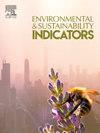Bridging the yield gap: Assessing the efficacy of adaptation measures for climate resilience under future scenarios
IF 5.6
Q1 ENVIRONMENTAL SCIENCES
引用次数: 0
Abstract
With climate variability posing significant global risks, semi-arid tropics are particularly vulnerable to the projected rise in radiative forcing, expected to shift monsoon rainfall patterns. Consequently, this heightened variability makes the development of climate adaptation increasingly challenging for rainfed rice. This study integrated bias-corrected CMIP6 projections (SSP245 and SSP585) with the FAO AquaCrop model and a Principal Component Analysis (PCA) to determine how climate adaptation strategies can close the yield gap (YG) and moderate water demand (WD) in the Upper Noyyal Basin, India (2020 2059). Six sowing weeks (SW), including two farmer-informed counterfactuals, were tested for both Kharif and Rabi growing seasons. Uncertainty analysis revealed that ensemble-averaged climate inputs reduced yield projection uncertainty. Under SSP245, water stress events become less frequent, with a 66 % reduction during the first two decades (2020–2039); SSP585 instead mitigates excessive rainfall events by 57 % in the later decades (2040–2059). Kharif rice sown in the counterfactual window outperforms shifted SWs, underscoring the value of indigenous knowledge. For Rabi rice, a two-week advance (SW38) narrows the YG by −65 % (SSP245) and −68 % (SSP585). PCA indicates that Water Stress Index (WSI) and Dry Day frequency (DD) jointly explain >90 % of the variance in YG and WD; under SSP585 these two variables dominate, underscoring a pivot toward high-frequency moisture shocks. This study pioneers a site-specific assessment through innovative counterfactual scenario, decadal-scale analysis to prevent maladaptation, and linking extreme indices to YG and WD under the effective adaptation strategy to quantify adaptation efficacy for policy guidance. These findings provide site-specific, time-bounded guidance for policymakers targeting resilient rice production under escalating climate uncertainty.
弥合产量差距:评估未来情景下气候恢复力适应措施的有效性
由于气候变率构成重大的全球风险,半干旱的热带地区特别容易受到预计的辐射强迫上升的影响,预计辐射强迫将改变季风降雨模式。因此,这种变异性的增加使得雨养水稻适应气候变化的发展越来越具有挑战性。本研究将偏差校正后的CMIP6预测(SSP245和SSP585)与粮农组织AquaCrop模型和主成分分析(PCA)相结合,以确定气候适应战略如何缩小印度上诺雅尔盆地(2020 - 2059)的产量缺口(YG)和适度需水量(WD)。对六个播种周(SW),包括两个农民知情的反事实,进行了Kharif和Rabi生长季节的测试。不确定性分析表明,总体平均气候输入降低了产量预测的不确定性。在SSP245下,水胁迫事件变得不那么频繁,在前20年(2020-2039年)减少了66%;相反,SSP585在以后几十年(2040-2059年)减轻了57%的过度降雨事件。在反事实窗口中播种的Kharif水稻表现优于转移的SWs,强调了本土知识的价值。对于拉比水稻,提前两周(SW38)将YG缩小- 65% (SSP245)和- 68% (SSP585)。主成分分析表明,水分胁迫指数(WSI)和干旱日频次(DD)共同解释了年降水量和日降水量90%的变异;在SSP585下,这两个变量占主导地位,强调高频水分冲击的支点。本研究通过创新的反事实情景和年代际尺度分析来预防适应不良,并在有效的适应策略下将极端指数与YG和WD联系起来,以量化适应效果,为政策指导提供依据。这些发现为决策者在气候不确定性不断升级的情况下瞄准抗灾水稻生产提供了特定地点、有时间限制的指导。
本文章由计算机程序翻译,如有差异,请以英文原文为准。
求助全文
约1分钟内获得全文
求助全文
来源期刊

Environmental and Sustainability Indicators
Environmental Science-Environmental Science (miscellaneous)
CiteScore
7.80
自引率
2.30%
发文量
49
审稿时长
57 days
 求助内容:
求助内容: 应助结果提醒方式:
应助结果提醒方式:


